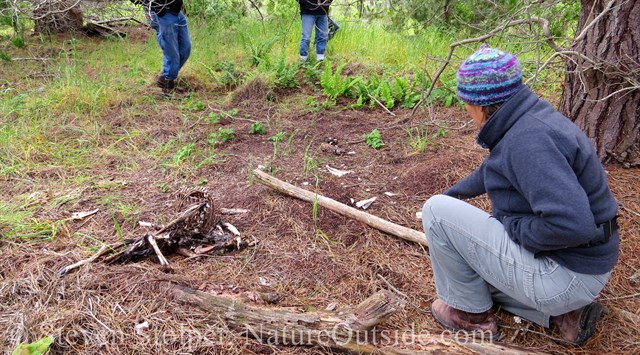
A Change of Plans
The best laid schemes o’ mice an’ men / Gang aft a-gley.
– “To a Mouse,” by Robert Burns (1785)
We scan the high overcast for patches of blue. We aren’t supposed to be here. Our plan was to meet at a beach 8 miles south of this marsh.
It’s time for the monthly meeting of the Bay Area Trackers. But unlike businessmen, we conduct our meetings on beaches and in forests. And today’s meeting will be held in marshland.
But that wasn’t the plan. We met at the beach at 8:00 AM to discover that high winds scoured the sand of track and sign. At this early hour, it was an unpleasant place to not see any tracks.
So being Mother’s Day, we deferred to Mother Nature and sought another location to explore.
And this marsh is perfect. Lush vegetation surrounds us. And trees provide shelter from the wind.

The Seven Signs
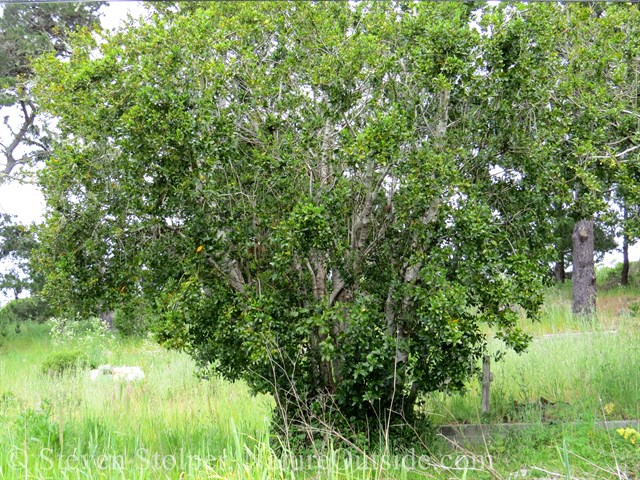
European species of Bay Tree
We tramp down a dirt road, overgrown with thigh-high grass. Eurasian collared doves call to us as we stroll. This dove is not a native species. They come from temperate and subtropical Asia. Introduced to North America in the 1980s, they reached California sometime around 2001.
Our leader cautions us about ticks. He suggests making our own path through the grass instead of taking established game trails where ticks lie in wait. I feel a pang of regret. I’ve been too busy to take my usual summer tick precautions.
We turn off the road and approach a European species of Bay Tree. I christen our impromptu trail “Tick Alley,” as I pick up three Pacific Coast Ticks on my pants in the space of 30 feet. I’ll end the day with eight ticks found on my pants legs.
As our group surrounds the Bay Tree, our leader poses the question, “How many animal signs can you find on this tree?”
As a group, we find seven:
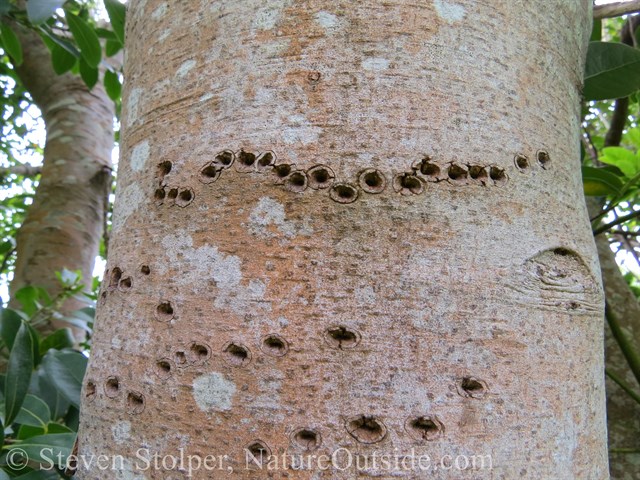
We find sapwells made by a sapsucker bird (Sphyrapicus sp.)
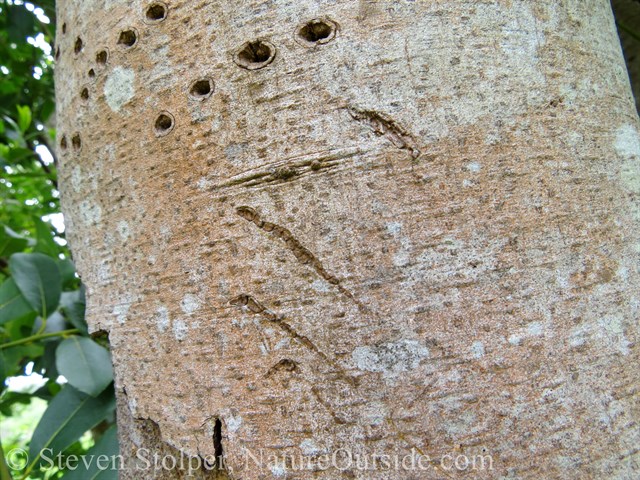
Raccoon claw marks on tree trunk
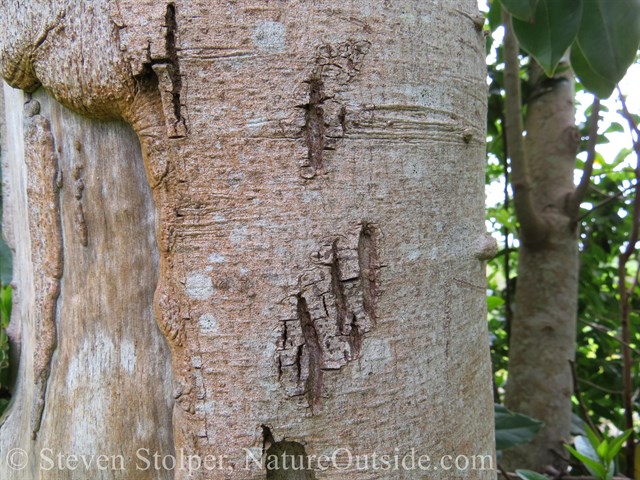
More raccoon claw marks

Deer browse. Because the shoots are tender, they snap right off. The tree has a stiff “skirt” of shoots often seen around heavily browsed trees.
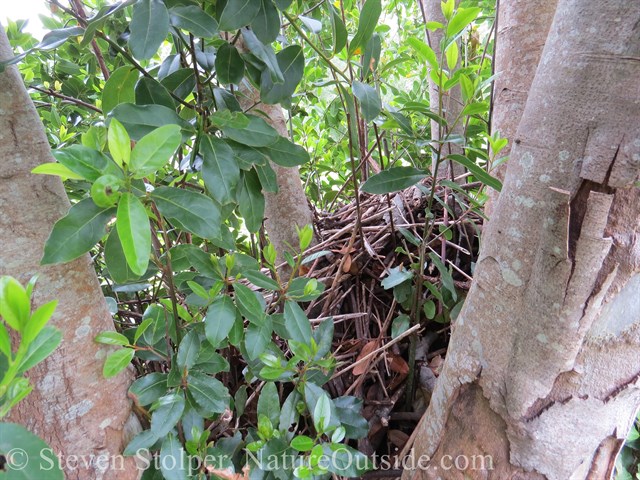
Woodrat’s nest in the center of the ring of tree trunks
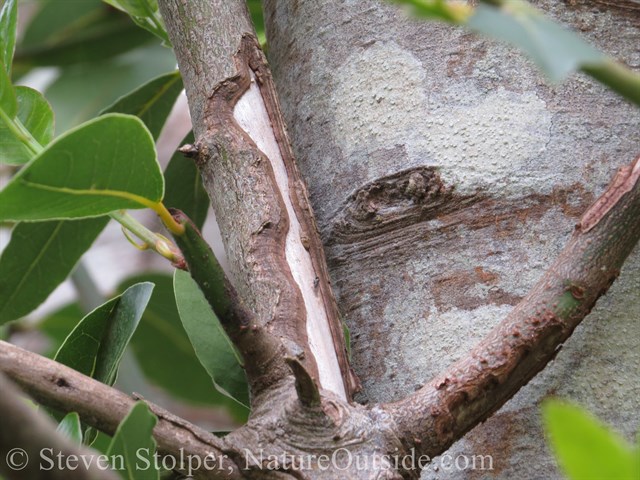
A woodrat (Neotoma fuscipes) has chewed the bark of this branch.
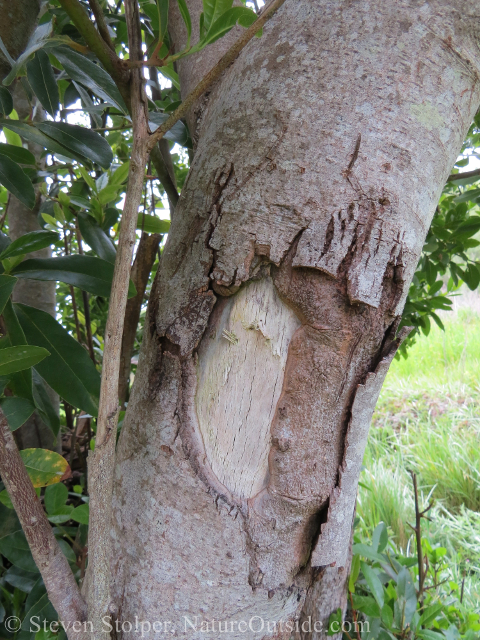
Human sign – The tree was scuffed by heavy equipment used to remove a cottage that once stood nearby
Trans-Dental Meditation
We leave the tree and hike on. Soon we find a curious pile of skull fragments underneath a stand of pine. We puzzle over a duck bill and the jaws of rodents and rabbits. One of the trackers explains that you can discern the rabbit jaws from the rodents because lagomorphs have “peg teeth” behind their incisors.
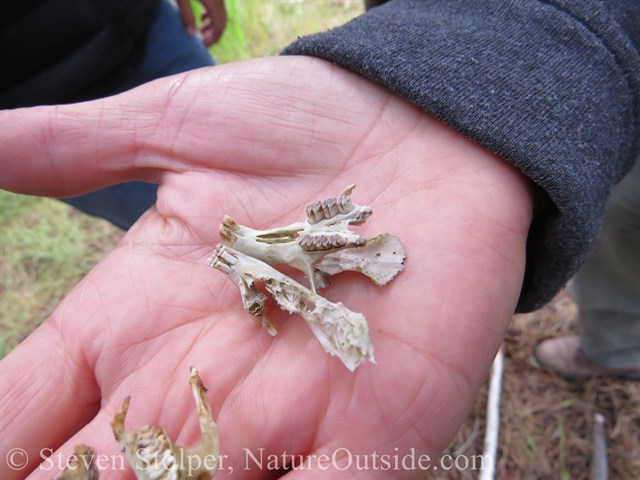
Jaw bones from lagomorph (left) and rodent (right)
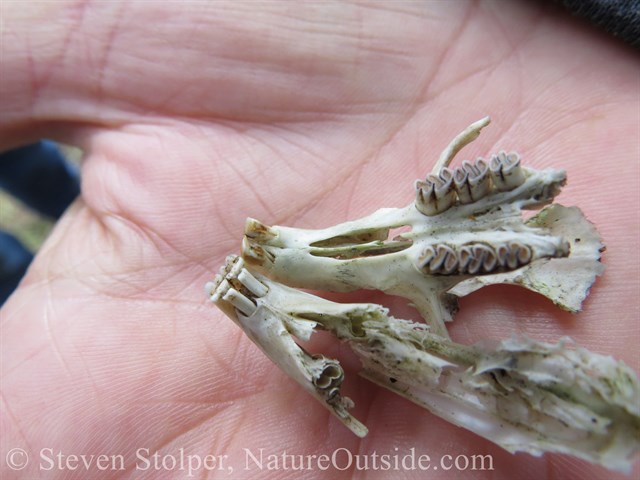
Notice the “peg” teeth behind the incisors (left). This came from a rabbit skull. The skull fragment on the right belongs to a rodent.
Several of us instinctively glance overhead at the branches above. We suspect a bird of prey has been using them as a perch to consume its meals.
Bobcat Departed
We march onward until we see a shocking site. It’s a dead bobcat.
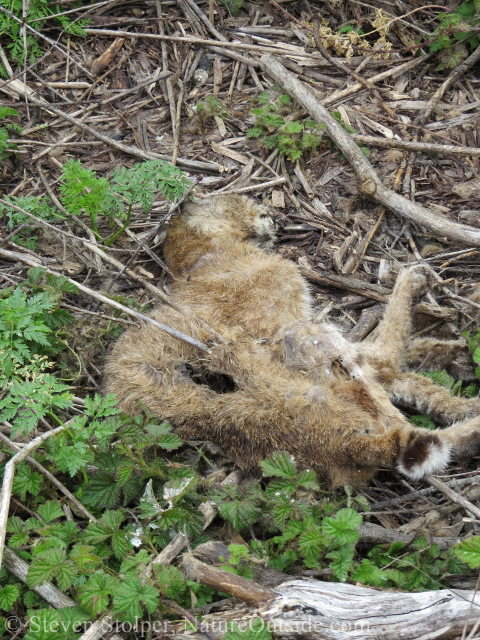
We are startled to find a dead bobcat
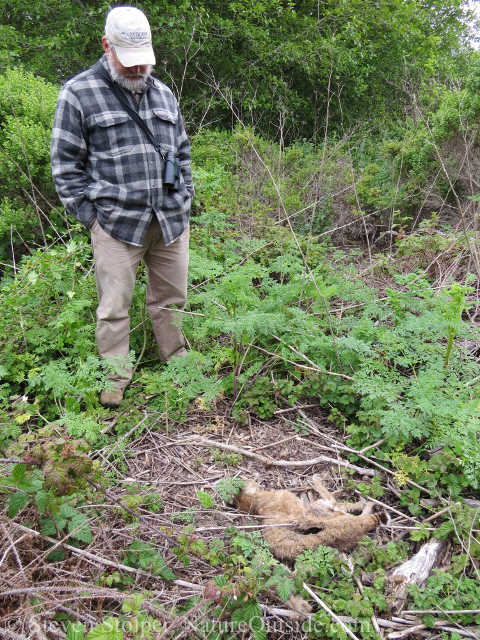
The carcass is out in the open, near a trail junction
The corpse emits the fetid odor of decaying flesh. We spot two types of maggots (fly larvae) crawling inside it. A Carrion beetle (Necrophila americana) searches for its next meal. It will hunt the maggots as well as consume some of the carrion. Females lay their eggs in the body for their own larvae to feast on the corpse1.
But how did it die? There is a gash in its side. But it was most likely caused by scavengers. Splashes of white uric acid on the ground implicate turkey vultures.
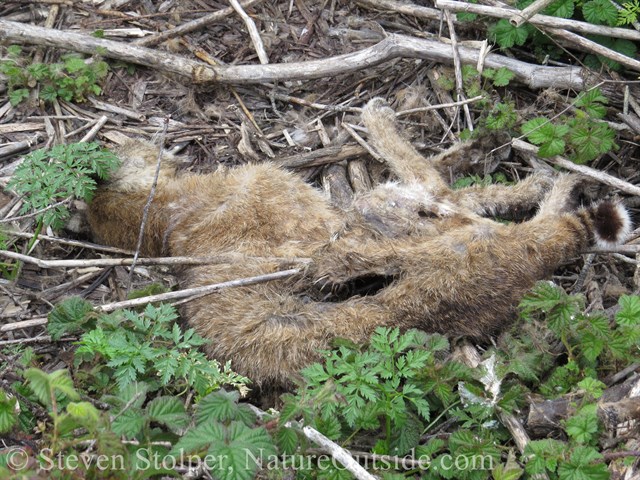
The gash in its side is most likely from a Turkey vulture. Notice the splash of white uric acid on the foliage.
This still leaves us bewildered. And as we bend over the corpse we notice a few details and begin to speculate.
It could be secondary poisoning. There are several farms in the area and it’s possible they use rat poisons. If the cat consumes enough poisoned rodents, it becomes ill and dies from the concentrated poisons in its tissues.
But this is not a place where a cat would choose to die. It’s out in the open, near a trail junction. There’s thick brush all around. And we think a sick cat is likely to seek a quiet secluded area under cover.
We also notice scat all around us. We are standing at the site of a latrine. A busy trail junction with dense bushes nearby… It’s a good site for an ambush. Or, an unexpected encounter with a larger predator.
Two of us notice a slight discoloration on the back of the cat’s neck. It looks like the fur may be disturbed. It’s possible that the cat may have been attacked by another animal. But without a close inspection, we have no way to determine the cause of death. And none of us feel inclined to get too cozy with the deceased feline.
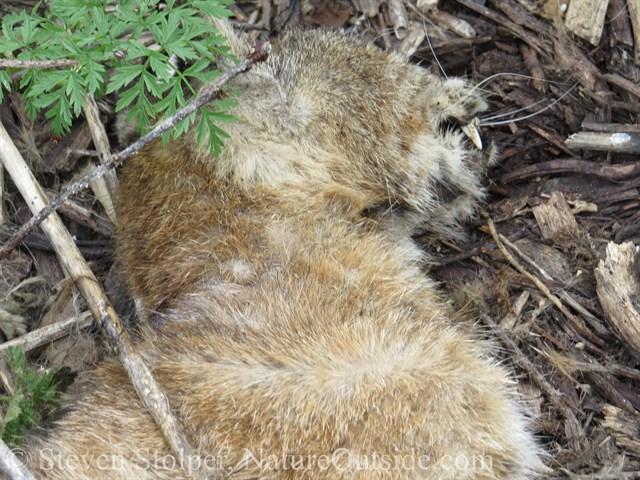
The hair looks “ruffled” and “torn” near the back of the neck. But this is inconclusive without a close examination.
Owl Pellet
We continue our journey and find an owl pellet. Breaking it open, we find a long rodent tooth. Rodent teeth are ever-growing. They are much longer than I had suspected. They seem to curve back into the jaw.
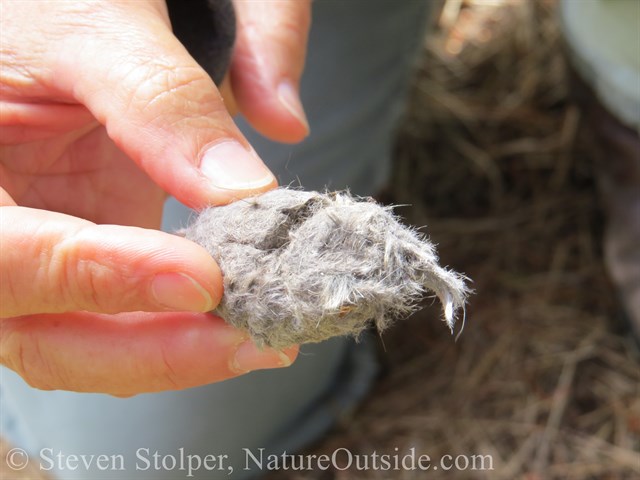
Owl pellet. I recommend wearing gloves when handling them.
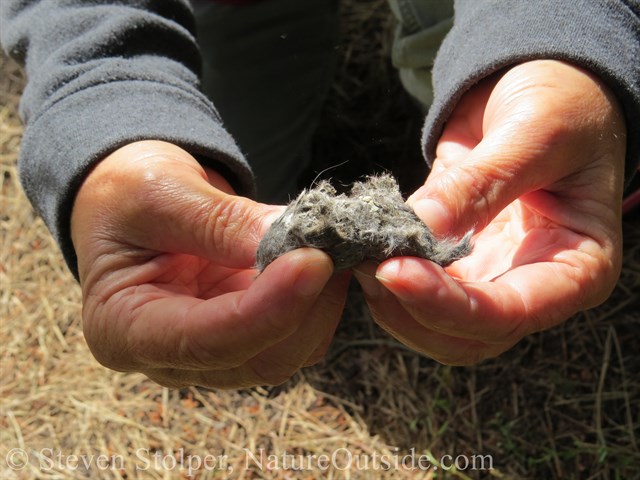
Opening the owl pellet. I recommend wearing gloves when handling them.
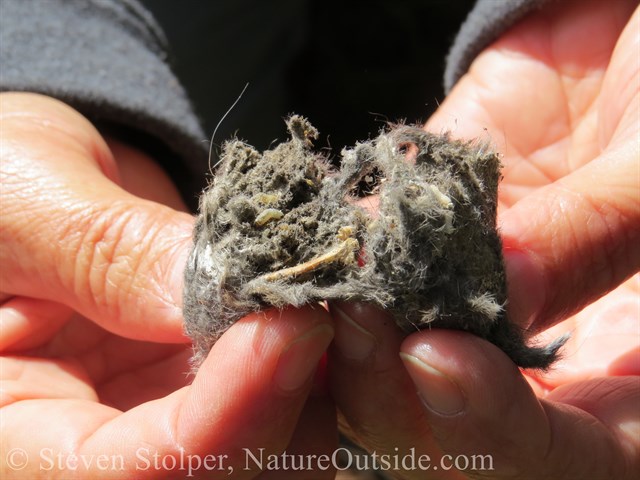
Rodent tooth and other bones in owl pellet. I recommend wearing gloves when handling pellets.
What Eggactly Happened Here?
We hike through the marsh and then loop back toward our cars. Overhead, a Northern harrier chases a Turkey vulture that strays into its territory.
Under a canopy of pines, we find a fascinating puzzle. A dozen large white egg fragments lay on a bed of pine needles. What I find remarkable is that the inside of the eggs are immaculate. Not a trace of yolk or albumen. Where did the eggs come from? Who broke them? And how did they get so clean?
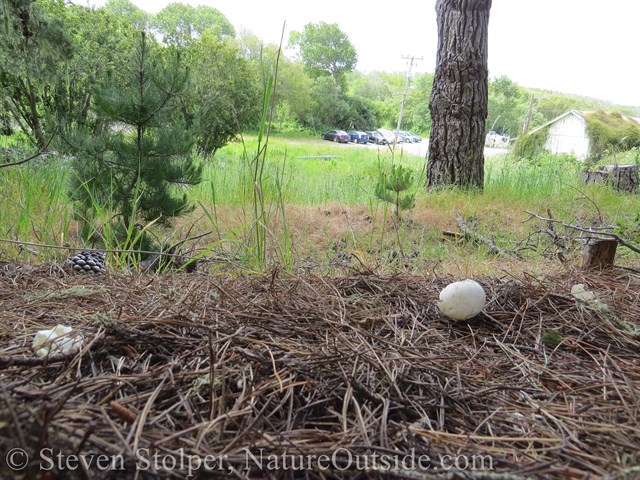
Egg fragments lying on the pine needle covered floor beneath a stand of trees
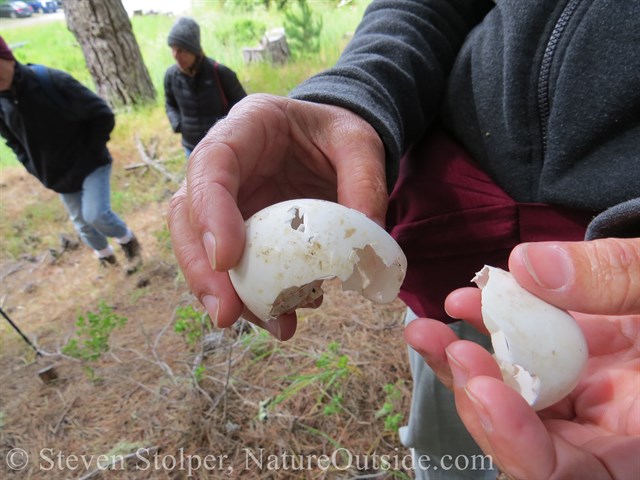
How did the eggs get here? What punctured them? And why are they so clean inside?
Several of us mention the poultry farm we passed on our way to the marsh. The farm has pens of geese and ducks protected by high fences. But the eggs didn’t get here on their own. Could ravens have carried eggs to this place? I learn from the others that skunks and raccoons love to eat eggs. Maybe they licked clean the egg shards left by the ravens?
Mountain Lion Cache and Carry
We hike under trees situated on a hillside. We have a commanding view of the surrounding country. Looking through the branches is like looking through a curtained window. It’s easy to peer out at the countryside. But the viewer is hidden from prying eyes by low branches and the shadows they cast.
I see an enormous hair-filled scat. It’s obvious at first sight that it came from a mountain lion.
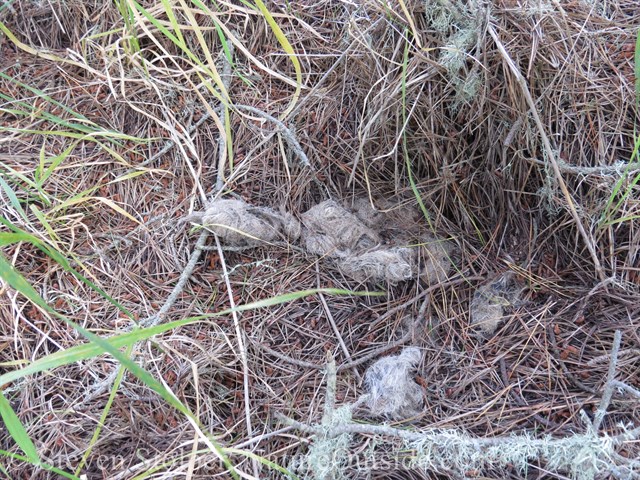
Mountain lion scat
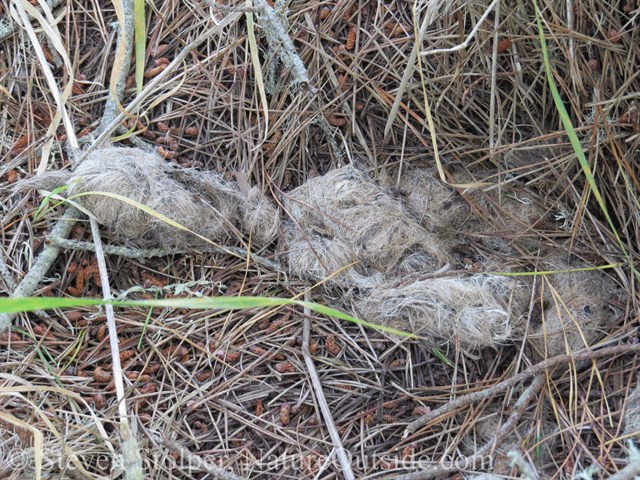
A closer look at the scat
But as we scan the area it’s apparent that something more is going on. We see clumps of deer hair scattered about. There is far too much to come from scat. And it’s closely cropped, as if sheered from the animal.
I become so excited that I forget to take pictures. We are standing where a mountain lion fed on a kill!
Lions like to cache their kills under cover of some kind. And the trees above our heads serve that purpose. The clumps of hair we find are characteristic of feeding sites. Lions will nip the hair off the body of a deer before they start chewing into it. It’s like a surgeon shaving a patient before an operation. The lion snips the hair with its incisors2.
We begin to search and find another, almost identical site nearby. One of the trackers explains that the lion would have fed several times on the carcass. It moves it to keep it away from the insect scavengers that become “activated” by the presence of a corpse. After seeing the bobcat, I can imagine why the lion would do this.
We continue our search and find a third spot. It’s by far the the most interesting. Here we find the remains of a small deer, probably a yearling.
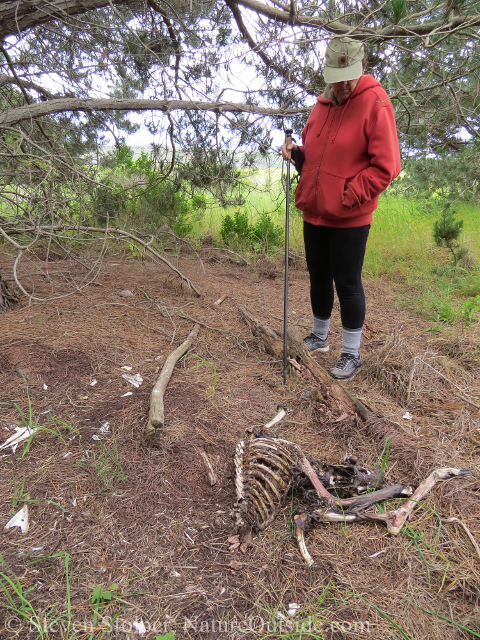
The remains of a meal. This is the hind part of a small deer.
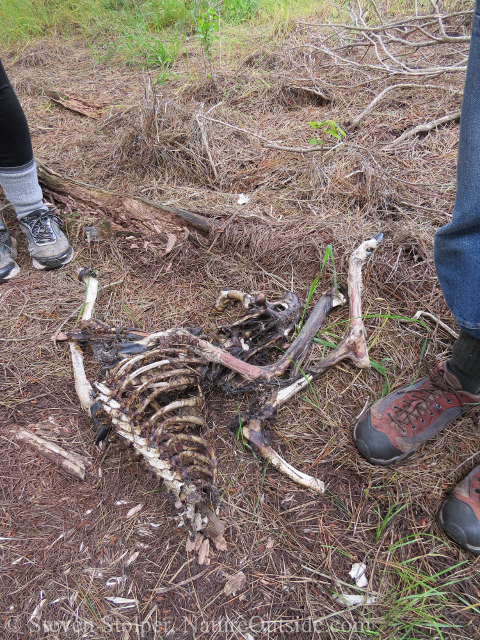
A closer look at the carcass.
The carcass is consistent with a lion kill. It is “whole” as opposed to pieces strewn over the landscape. And the contents of the chest cavity are missing.
Mountain lions tend to eat the chest-area organs first (lungs, heart, liver). They chew a hole in the ribs to get to these tasty and most-nutritious morsels.
Lions remove the stomach and bury it in the vicinity. This prevents stomach acids from spoiling the meat over the 3-5 days it may take for the lion to consume a good size deer2.
The other clue is that we find the hind part of the carcass. If coyotes had killed the deer, they would have started eating at the hind end and strewn body parts all over the area.
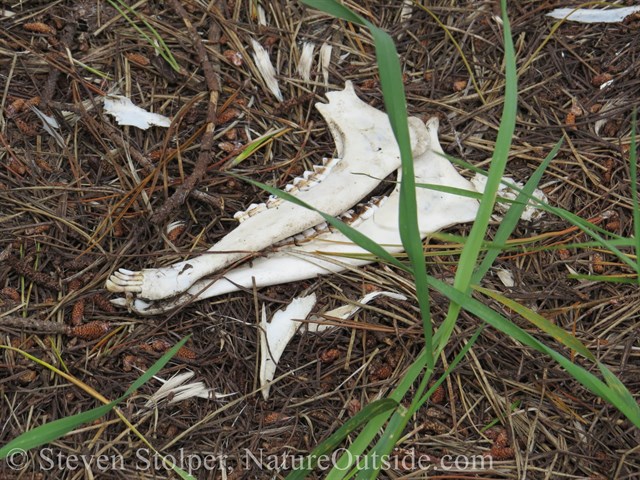
Deer mandibles
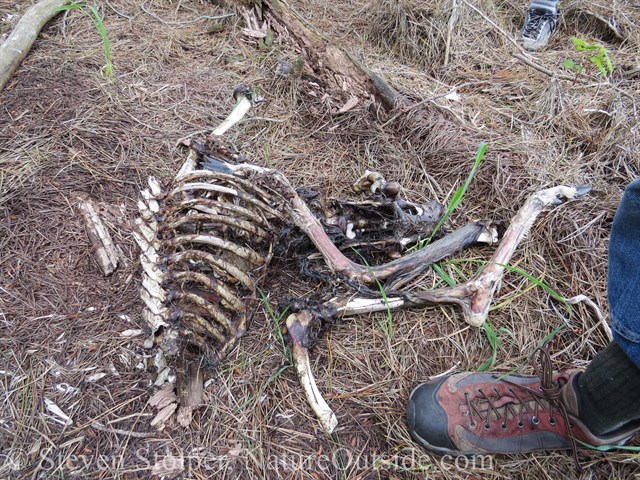
This is a small deer, possibly a yearling. Compare to the hiking boot for scale.
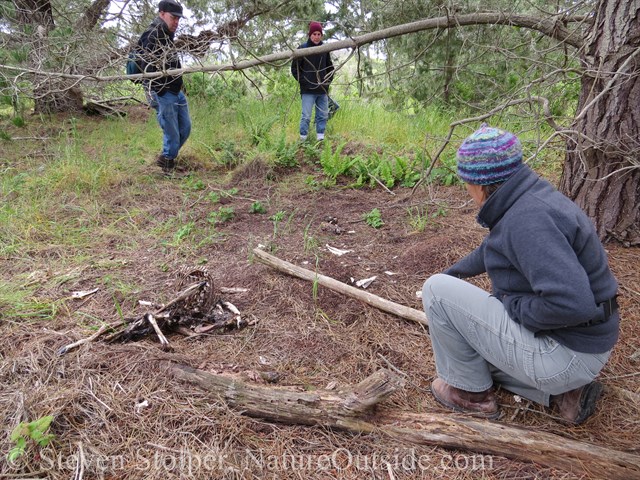
A feeding spot
As I circle around the hillside, I find a spot where an animal bedded down in the tall grass. It commands a wide view of the area, but is sheltered and concealed. Could the mountain lion have rested here? Or maybe the yearling?
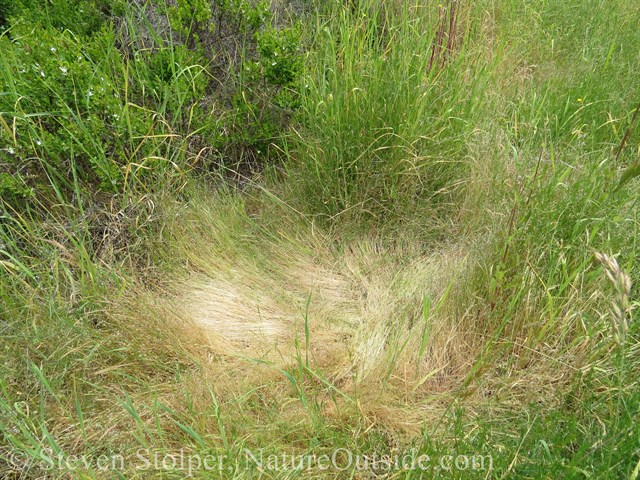
Mystery bed in tall grass
The End of the Day
Like all of our tracking hikes, we leave with more questions than answers. But the experience, and the questions, teach us about the hidden natural world around us.
References
Related Articles on NatureOutside
Mysteries on the Beach (Part 1)
Change Your Trail to Change Your Attitude
For fun facts and useful tips, join the free Bushcraft Newsletter.



Wow! Great info. Thanks.
You’re welcome, Hal!
Hi, interesting article. I just encountered a cougar kill, it killed a deer on a grass patch, next to my house. Then it dragged it into the forrest, and up a hill. I didn’t see more. I am wondering how far they drag it away from where they killed it. Of course, I am not going to look for it.. We are being careful and respectful, instead of letting our dog loose, we walk it on the leash right now. Any info or advice you can give me? Thanks.
Wow, how exciting! Linda, it is difficult to predict how far a lion might drag a kill. I have seen them relocate a kill several times in a relatively small area to foil scavenging insects and other animals.
It sounds like you are taking wise precautions. I am told that mountain lions can consume a deer in just a few nights. But to stay safe, I would avoid the area for 6 to 12 days. By then, the cougar should have made another kill.
Really cool article! I grew up on 40 acres on prime big cat territory and my parents taught us to be careful when we were out in the woods. I realized we had a mountain lion in our midst when we found a deer carcass in my low old oak old tree fort. Besides all of the neighbors animals going missing…..a little eerie but really cool at the same time.
Ashley, thanks for sharing your experience. Few of us get to live close to Mountain Lions for as long as you did. I’m curious to know if in all that time you ever saw one.
My poor sweet Dachshund pup was taken from my fenced yard by what I’m assuming was a bobcat or a mountain lion. I heard it happen but by the time I got to the site they were both gone. No evidence on the ground of a scuffle and my pup was gone… so devastating!!
How would I know which big cat got him?
Hi Katie,
I’m sorry to learn of your loss.
Depending on your location, it could be coyote, bobcat, or mountain lion. You need to search the ground around the scuffle or locate the point where the predator entered/exited your yard. Search for tracks and try to match them to the culprit. You can also look for scat in the area to try and figure out which predators are nearby.
I hope things work out for you.